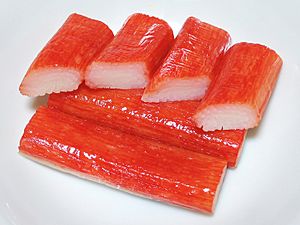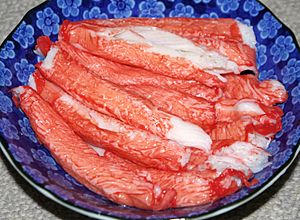Crab stick facts for kids

Crab sticks – imitation crab meat surimi.
|
|
| Alternative names | imitation crab meat, seafood sticks, krab |
|---|---|
| Place of origin | Japan |
| Main ingredients | white fish |
Crab sticks are a popular seafood product. They are also known as imitation crab meat or seafood sticks. Even though they look like crab legs, they are not made from real crab meat. Instead, they are made from a special type of fish paste called surimi. This paste is shaped and colored to look like crab.
Contents
The Story of Crab Sticks: How They Were Invented
The first imitation crab meat was made in Japan. A company called Sugiyo Co., Ltd. created and patented it in 1974. They called it Kanikama. This first version was a flake type.
Then, in 1975, another Japanese company, Osaki Suisan Co., Ltd., invented and patented the crab stick shape we know today.
In 1977, crab sticks were introduced to other countries. A company from California, USA, worked with Sugiyo to share them worldwide. In Japan, they are still often called Kanikama. But in other places, they have names like Krab Sticks, Ocean Sticks, or Sea Legs. Because they don't contain real crab, many places now require them to be called "imitation crab" or "seafood sticks."
What Are Crab Sticks Made Of?
Most crab sticks today are made from a type of fish called Alaska pollock. This fish lives in the North Pacific Ocean.
The main fish ingredient is often mixed with other things. These can include fillers like wheat. Egg white, also called albumen, is often added to help bind everything together. Sometimes, a special enzyme called transglutaminase is used for binding too.
To make them taste like crab, a special crab flavoring is added. This can be natural or artificial. Finally, a layer of red food coloring is put on the outside. This makes them look even more like real crab legs.
How Are Crab Sticks Used?
Crab sticks are used in many different dishes. In California, they are very popular in California rolls. These are a type of makizushi (rolled sushi) often found in sushi restaurants. They can also be used in salads, sandwiches, or eaten on their own.
See also
 In Spanish: Palito de cangrejo para niños
In Spanish: Palito de cangrejo para niños


